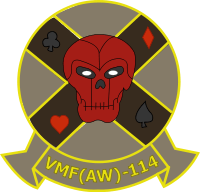VMF(AW)-114
| Marine All-Weather Fighter Squadron 114 | |
|---|---|
|
VMF(AW)-114 Insignia | |
| Active | July 11, 1943 – July 1, 1963 |
| Country | United States |
| Branch | USMC |
| Type | Fighter squadron |
| Role | Air interdiction |
| Part of | Inactive |
| Nickname(s) | Death Dealers |
| Tail Code | LK later EK |
| Engagements |
World War II * Battle of Peleliu |
| Aircraft flown | |
| Fighter |
F4U Corsair F9F-8 Cougar F2H Banshee F4D Skyray |
Marine All-Weather Fighter Squadron 114 (VMF(AW)-114) was a fighter squadron of the United States Marine Corps during World War II and continued in service until their deactivation in July 1965 . Known as the “Death Dealers”, they made their biggest mark providing close air support during the Battle of Peleliu and remain in an inactive status today.
History
World War II
Marine All-Weather Fighter Squadron 114 was activated on July 11, 1943 at Marine Corps Air Station El Toro. They remained on the West Coast of the United States until August 1943 when they transferred to Marine Corps Air Station Ewa, Hawaii. In Hawaii, they continued their training until moving to Midway Island on December 18, 1943. They returned to Ewa in February 1944 and in March they moved first to Espiritu Santo and the Green Island. While there, they flew strike missions against Japanese garrisons that had been bypassed in the Bismarck Islands.
The first major combat that VMF-114 took part in was the Battle of Peleliu. The squadron arrived on Peleliu on September 17, 1944 and provided most of the close air support (CAS) for Marine Corps forces during the course of the battle. They also provided the preparatory bombing and CAS for the 3rd Battalion, 5th Marines when they assaulted Ngesebus during the battle.[1] The terrain on the island, earlier judged unsuitable for anything but the costliest and most difficult advances, was made passable with the aid of preparatory fire-scouring by napalm bombs from 114.[2] MajGen William H. Rupertus, the Commanding General of the 1st Marine Division on Peleliu would say following the battle that the air support provided during the campaign was, "executed in a manner leaving little to be desired.[3] Following the battle, they remained based on the island again assuming the role of attacking bypassed Japanese garrisons in the vicinity of the western Caroline Islands. The squadron remained in the area until they ceased combat operations on June 1, 1945.
Post-war years
Following the war, VMF-114 escaped the post-war drawdown of forces and were transferred to Marine Corps Air Station Cherry Point in February 1946. In August 1947, the squadron was redesignated Marine Night Fighting Squadron 114 (VMF(N)-114) after they were reequipped with the nightfighter version of the F4U Corsair. Within a few years, the squadron transitioned to the F2H Banshee and on June 1, 1953 they were again redesignated VMF-114. On January 7, 1953, the squadron deployed to the Mediterranean Sea as part of Carrier Air Wing 10 (CVG-10) onboard the USS Tarawa (CVA-40). They returned from this deployment on July 3, 1953.
_USS_FD_Roosevelt_1959.jpg)
The “Death Dealers” were again redesignated on May 1, 1957 as Marine All-Weather Fighter Squadron 114 (VMF(AW)-114) and transitioned to the F9F-8 Cougar and then to the F4D Skyray. From February 13, 1959 – September 1, 1959, the squadron was deployed as part of Carrier Air Wing 1 (CVG-1) on board the USS Franklin D. Roosevelt (CVA-42). Upon their return they went back to the normal deployment rotation including a stint at Naval Air Station Roosevelt Roads. In January 1961, the squadron was transferred to Naval Air Facility Atsugi, Japan where they served until the squadron was deactivated on July 1, 1963;
Awards
 Navy Unit Commendation September 15, 1944 – January 31, 1945
Navy Unit Commendation September 15, 1944 – January 31, 1945
See also
- United States Marine Corps Aviation
- List of active United States Marine Corps aircraft squadrons
- List of inactive United States Marine Corps aircraft squadrons
Notes
- ↑ Sledge With the Old Breed, p.110.
- ↑ Gayle, Gordon D. (1996). "BLOODY BEACHES: The Marines at Peleliu - The Umurbrogol Pocket: Peleliu's Character Distilled". Marines in World War II Commemorative Series. History and Museums Division, Headquarters, U.S. Marine Corps. Retrieved February 12, 2007.
- ↑ Sherrod(1952):257.
References
- Bibliography
- Crowder, Michael J. (2000). United States Marine Corps Aviation Squadron Lineage, Insignia & History - Volume One - The Fighter Squadrons. Paducah, KY: Turner Publishing Company. ISBN 1-56311-926-9.
- Doll, Thomas (2000). Night Wings: USMC Night Fighters, 1942-1953. Carrollton, Texas: Squadron/Signal Productions.
- Mersky, Peter B. (1983). U.S. Marine Corps Aviation — 1912 to the present. Annapolis Maryland: The Nautical and Aviation Publishing Company of America. ISBN 0-933852-39-8.
- Rottman, Gordon L. (2002). U.S. Marine Corps World War II Order of Battle - Ground and Air Units in the Pacific War, 1939 - 1945.’’. Greenwood Press. ISBN 0-313-31906-5.
- Sherrod, Robert (1952). History of Marine Corps Aviation in World War II. Washington, D.C.: Combat Forces Press.
- Sledge, Eugene B. (1990). With the Old Breed: At Peleliu and Okinawa. Oxford University Press. ISBN 0-19-506714-2.
- Web

